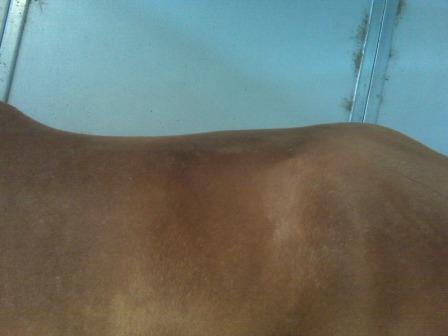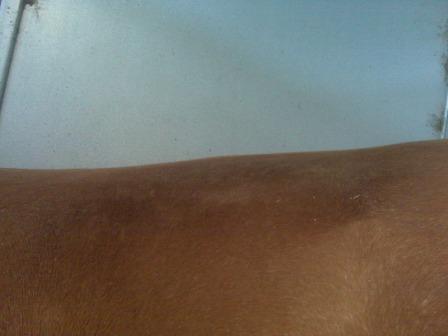Site Menu:
| This is an archived Horseadvice.com Discussion. The parent article and menus are available on the navigation menu below: |
| HorseAdvice.com » Diseases of Horses » Lameness » Diseases of the Spine, Back & Pelvis » Topics on Diseases of the Back Not Covered Above » |
| Discussion on Pig Backed | |
| Author | Message |
| New Member: jydy |
Posted on Sunday, May 17, 2009 - 11:23 pm: I have a six year old quarter horse gelding with a raised spot in his spine towards the hip area. I had an old cowboy tell me they called it "pig backed". Has anyone ever heard this term and what does it mean? |
| Moderator: DrO |
Posted on Monday, May 18, 2009 - 7:03 am: Hello DDY,This is a new term to me. Could you photo the horse and post it here? Best is two shots, one from the side and one from the rear. I would be glad to comment. Your description could be of a hunter bumps. For more on this see, References » Equine Illustrations » Leg Anatomy and Conformation » Sacroiliac Joint and Hunter Bumps. DrO |
| Member: hollyw |
Posted on Monday, May 18, 2009 - 8:37 am: I'm thinking it's another term for "roach-backed," in which the back has a more raised profile than what is considered normal. |
| Member: hollyw |
Posted on Monday, May 18, 2009 - 8:46 am: P.S.When I was a pre-teen, and before I got my first horse, I had a 3-ring binder book on Horse Care that came from a local serum company. I read that thing backwards and forwards, and even though some of the medical info has been reworked over the years, the conformation portion of the book has been invaluable to me in giving me a good eye. One of the drawings in the book was of a roach-backed horse. I just did a quick Google search and found a short and interesting link that doesn't provide a picture, but explains the value in the different back conformations. https://www.helium.com/items/571523-horse-anatomy-the-back |
| Member: morg1 |
Posted on Monday, May 18, 2009 - 5:27 pm: I'm thinking I've read of a bump on the back of a horse near the hip referred to as a "hunter's bump." I'm not sure where I read that, but that's what came to mind when I read your post. |
| Member: jydy |
Posted on Monday, May 18, 2009 - 8:15 pm: I have included two pics with this post. Both are from the same side which shows the profile best. It is slight, but there never the less. You can not see it from the rear, but I will take some rear pics if you think they will help after seeing these. Thanks 
|
| Member: hollyw |
Posted on Monday, May 18, 2009 - 9:07 pm: Yes, this is roach-backed (and in one reference, I found it called "hog-backed.")Roached back [18] In the area where the back and loins join the croup (the coupling) there is an upward convex curvature of the spine. Often a result of a short back, or injury or malalignment of the lumbar vertebrae. Often accompanied by less-developed loin muscles in breadth, substance, and strength. The spine already “fixed” in a curved position, and the attaching muscles are unable to contract properly to round or elevate the back. Thus it is difficult to engage the hindquarters or round the back by elevating loin muscles. Vertebrae often have reduced motion so the horse takes shorter steps behind. Jumping and dressage especially are affected. The horse is stiffer through the back and less flexible in an up and down motion as well as side to side. There may be back pain from vertebral impingement. There is a less elastic feel beneath rider as the back too rigid. Agility sports (polo, cutting, reining, barrel racing, gymkhana) are more difficult." |
| Member: sodmonst |
Posted on Monday, May 18, 2009 - 10:58 pm: This looks like what we used to call "hog backed." I had a trail horse years ago that had a back that looked very much like this. I guess there are always exceptions to the general that H W posted. She had a lovely ground covering walk, smooth trot, and a nice rolling canter. Of course, she wasn't a jumping or dressage horse, but she was a great trail and lesson horse. |
| Moderator: DrO |
Posted on Tuesday, May 19, 2009 - 7:35 am: I disagree with the assessement of a roach back here. A roached back is sort of the opposite of a sway back. It is a general convex curvature of the whole thoracolumbar spine, think of the back of a roach in profile. Or a hunch back. But neither is that a hunter bump as it is too far forward.What we have in the photo above is a focal swelling over the top of the terminal thoracic vertebrae. If is hard to know if the swelling originates from subcutaneous, muscle, tendinous, or skeletal tissue as all lie under that point. When seen acutely, trauma is the most likely explanation, possibly from rough housing with other horses or possible trying to get under a limb too low. But it is a common enough finding and not often associated with long term problems. As to whether you want to call it "pig backed"...I don't think it looks much like a pig's back either. DrO |
| Member: jydy |
Posted on Tuesday, May 19, 2009 - 9:16 am: Thanks for all the posts. I feel much better with Dr. Oglesby's assessment. My horse is a barrel horse currently running 2D times and I was greatly concerned with roached backed. His gate is very smooth. However, there are issues with him using his hindquarters behind the barrel. I intend to have him evaluated by a chiropractic vet. Can you offer any other suggestions for evaluation, treatment, exercises, stretches etc... I truly want his barrel career to last a long time and any preventive measures I can take will be helpful.Thanks again, DDY |
| Moderator: DrO |
Posted on Tuesday, May 19, 2009 - 9:59 am: What are you treating DDY? Is this bump just come up recently or are there other issues than just the appearance?DrO |
| Member: hollyw |
Posted on Tuesday, May 19, 2009 - 11:28 am: Sorry if I mislead. The photo I found with the reference above looked exactly like that photo you posted.The drawing in the old book I have doesn't show a bump but a straight back . . . with no "seat" behind the withers. Hope, if it's an injury, that it will resolve with care and your horse will be able to move comfortably. |
| Member: jydy |
Posted on Saturday, May 23, 2009 - 9:12 am: DrOHe had the bump when I bought him two years ago so it is nothing new and I do not know how he come to have it. As far as performance, he has a really smooth gate. He does not display any bad habits (pinning ears when cinching, bucking, rearing, head throwing). He is willing to do whatever asked. He does not seem to use his rear end to push off behind the barrel. He almost hops behind the barrel with his hind legs and pulls with his front legs. He also sometimes will not hold the correct lead in his back end. Any ideas? |
| Moderator: DrO |
Posted on Sunday, May 24, 2009 - 7:24 pm: DDY you say it your self: they have been there two years with no signs of change or health problems. Above I outline a fairly long list of possible structures but even knowing the exact structure involved you cannot know the nature of the swelling without imaging and possible biopsy. Trauma would involve chronic inflammatory related swellings that have left a scar or bony enlargement not requiring treatment. Personally I would have trouble justifying spending much money on it.DrO |
Horseadvice.com
is The Horseman's Advisor
Helping Thousands of Equestrians, Farriers, and Veterinarians Every Day
All rights reserved, © 1997 -
is The Horseman's Advisor
Helping Thousands of Equestrians, Farriers, and Veterinarians Every Day
All rights reserved, © 1997 -
